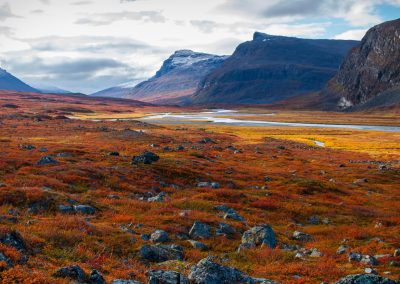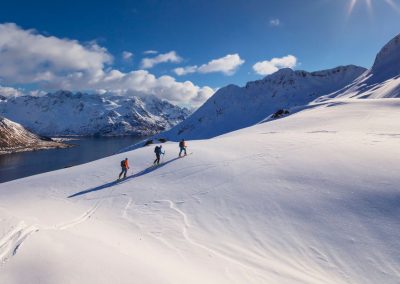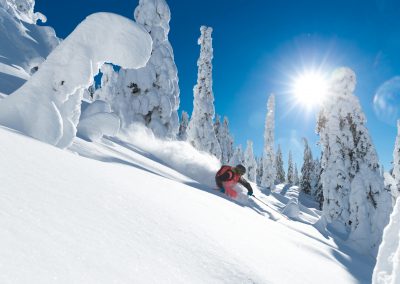Most common mistakes when hiking
April 2020, by Markus Nyman
To go out on a hike is a wonderful experience but there are a few things that can ruin it all. We have all been beginners once upton a time. Here are some of the problems we face when mountain hiking.
Mistake number one: Not getting out of the couch.
Okay, the most common mistake has probably already occurred before you get your feet into your boots. When you are about to go out hiking it is all too easy to stop before you even leave the front door. Maybe it feels too troublesome, or the weather forecast says that it will be too rainy, too cold or too warm. So make sure this mistake will not hinder you from exploring the nature.
Blisters on your first day of a hike
Blisters i probably the mistake that is easiest to know of. Most people have had it and know how painful it is on every step and it feels like walking on glass. To avoid blisters is the key for all happy hikers, no matter how far you are going or what is your target. It is so much easier to prevent a blister than to take care of it once you got it. They do heal somewhat slowly as well. Make sure you put tape on your feet, preferably before the hiking starts. Special tape for avoiding blisters are available and something we as guides always pack with us. Blisters are created by friction, so make sure to avoid wearing cotton socks. If your boots or shoes are well broken in and if you change your socks a few times throughout the day it will really make a difference. Depending on your boots, it will different amount of time to break them in so do it well in advance.
To not make a plan
A hiking plan is when we as a team sit down and make a route and logistics plan for the hike. This includes the timeline, distance, type of terrain, group, equipment, risks and dangers but also things like what time of the year would be best suited to hike in this area. Making a plan together makes sure everyone is well understood of how the hike will be, what the challenges will be and how long the days will be. The plan can also be given to someone back home so that someone knows the route if you should need help.
Just do not forget to put in a few extra days for resting. Forgetting this is a common mistake when hiking in the mountains. A good rule is to rest every fourth day or making sure that every third day will be a much shorter in distance.
Really, there is a lot to think about and Deep Wild Scandinavia can help you plan your adventure either in person, by email or video conference.
Bringing too much stuff
A very common mistake when hiking is to bring too much stuff with you. To overpack basically. Everything you bring – you will have to carry, so try to find things that are multi purpose and has different functions. A headtorch can be used to find something inside the tent during the night, but also used to signal in case of an emergency. This way you may not need to carry a big and bulky tent lamp.
With that said, remember that if you are to pack ultra-light you will also need ultra-knowledge. Having the skillset to adapt to different situations is of course much more important than bringing all the gear you have, with no knowledge how to use them. After a couple of hikes you will learn which parts to leave at home and which parts that are really important to bring with you.
Learn to hike in the mountains
On our tours and courses you will learn how to hike in the best way possible. We will guide you through a magic mountain environment with amazing views. Experience the sunlight around the clock during mid summer or the burst of colours on an autumn hike. Learn more from our experienced guides and instructors and get tips and answers to any questions that may apply to you.
Too unfit to hike
Here it is all about having done the homework. Too many that are heading out hiking discover too late that they are too unfit. It may be the feet and shoulders need to adapt and get used to carrying the weight of a rucksack. Knees and the core muscles are other parts that may produce trouble after a while. A pro tip is to train a few times before hiking, preferably in untracked terrain with the kind of boots and rucksack (including weight) that you intend to have on your hike.
Starting too late
Many mistakes can be avoided as long as we start early. This gives us time to turn around or adjust the pace and plan accordingly. If you intended to set off at 9 in the morning but get started right after lunch instead, then you may have a risk of it getting dark well before you get there. This of course depends on where and when you are hiking. Above the arctic cirle in the middle of summer will not give you this problem but the point is start early.
To hike in daylight versus darkness is two different things. A simple thing as finding your way, staying on track and not getting off the path can be a real problem when the visibility goes away. If you intend on going for a summit push, make sure you have enough time to get back and that you try to have some margins.
Rough terrain
To miscalculate the terrain is another pitfall. Some may think that 15 kilometers home in the training tracks does not take very long time, but once in the high mountains the terrain can be very different. Everything from easily hiked tracks to blocks of stone and thick bush terrain almost like a djungle. Follow the trails and you will have the highest chance to have an easy walk.
The weather shifts quickly
The weather can of course also shift and it requires you to be extra prepared for the warm sunny days but also high winds with rain coming from the side – or snow in July for that matter. Bring a wool hat just in case and never go out without your rain gear.
Picking the wrong camp site and not using the guy lines
To sit inside your tent on the wrong place can cost you your nights sleep, or give you a wet awakening. Try to avoid wet hollows in the ground when you pitch your tent as these tend to be very moist and where rainwater gathers. Also avoid pitching your tent all too close to any roaring rivers. Always put up your guy lines on the tent so that if the weather turns for the worse, you do not have to go out in the middle of the night with pouring rain only to re-pitch your tent.
Not keeping up with the map and compass
Not keeping up with the map and compass is one of the more rookie mistakes if you are going out hiking. Partly, it is important so that you do not get lost but it also prevents you from venturing into dangerous areas such as cliffs, rapids or avalanche prone areas. Not to mention that if you need to call for help it is very important to know where you are and being able to convey this information to the person on the other end. If you need to call for help – can you describe accurately where you are in 15 seconds?
Not saving on the batteries
Sure, the batteries may signal 100% when you are home in the warmth preparing for the adventures but once you get outside and maybe have been outside 24 hours they may not be so full anymore. Try to double check batteries and if possible (check the item manual) use rechargable batteries so you can keep full batteries without having to recycle half empty ones.
Most people are used to having an electricity outlet close by. So when we are mountain hiking it is important to save your resources so they last longer. Even if you should not count on being able to use your phone, it may be a vital part of your equipment in case something happens. Without cell coverage there may be a small chance that you are able to call the emergency service anyway but if there is no batteries there is no chance you will be able to make the call. Turn off the mobile phone, turn on the battery saving mode, deactivate apps or use the flight mode if all you want is to take a picture. When you reach the summit, you can turn off the flight mode and maybe you will have some cell coverage.
Bad hygien
The most common reason for becoming sick when hiking in the mountains is often bad hygien and not washing your hands properly. To be sick and lying in a tent in bad weather is no fun, that is why we always make sure we have a good introduction into how we do our business in the nature and how we maintain a good hygien – especially after visiting the toilet or before we cook. This is super important.
Hey! I'm Markus 👋
In the last decade, I have had the chance to lead a number of trips in the Scandinavian wilderness almost every week. Now I want to take the opportunity to invite you to join.
Look at the tours & courses part of the website, and let me know if you find anything interesting.
You can reach me directly at markus@deepwild.com
Markus Nyman
Guide & Founder, Deep Wild Scandinavia














